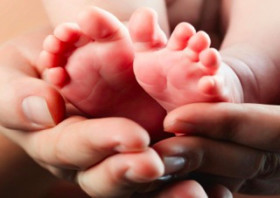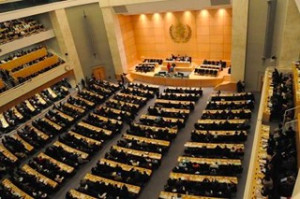2014
As 194 governments endorse the Every Newborn Action Plan, a neglected population receives its needed focus and the path to achieving MDGs 4 and 5 becomes clearer

The endorsement of the world’s first plan to eliminate preventable newborn deaths and stillbirths by the World Health Assembly in Geneva today marks a new dawn for the newborn. All 194 governments who endorsed the Every Newborn Action Plan are to be congratulated on this historic commitment to the health and development of babies. The global community has now fully embraced a neglected population – the 5 million newborns and stillborns who die every year and the millions of mothers, fathers and families who have been on the sidelines of the child survival revolution to this point. But not any longer.
With only 587 days remaining in our race to achieve the Millennium Development Goals, it is abundantly clear that – despite our great progress in reducing maternal and child deaths – we will not be able to reach the finish line without putting the smallest and most vulnerable babies and their mothers at the top of the global health and development agenda. With nearly half of all child deaths now occurring in the first month of life, there is wide recognition that reducing newborn deaths is the final frontier in the battle to end preventable child deaths and create the world’s healthiest generation of children. By including the 2.6 million stillborn babies in the global child survival agenda for the first time, we have taken a major step forward for the millions of families who have suffered silently and for the babies who have died anonymously.

The 67th World Health Assembly was the occasion where 194 governments endorsed the Every Newborn Action Plan.
The Every Newborn Action Plan gives us six big, bold ideas to drive the next wave of progress, and our collective success will depend on how effectively we turn these ideas into action:
- The “Triple Return”
With about half of all deaths of mothers and babies occurring around the time of birth, investments targeted at improving the quality of care during this critical period of time can simultaneously reduce maternal deaths, newborn deaths and stillbirths, delivering a “triple return” on investment. The Lancet Every Newborn series released on May 20th, 2014, quantifies this return as three million deaths prevented each year – 200,000 women, 800,000 stillbirths and 2 million newborns – with high coverage of care. This demonstrates the value of integration in the delivery of health services: we are not only improving our ability to save more lives more cost-effectively, but we are also delivering more value for patients, in this case, mothers and their babies. This is the direction that Jim Kim, Paul Farmer and Michael Porter argued so powerfully for in “Redefining Global Health Care Delivery” last year. In retrospect, the separation of babies from mothers in two different Millennium Development Goals (4 & 5) has acted as a barrier to integrated service delivery and to fully capturing the “triple return”. The Every Newborn Action Plan gives us the opportunity to redress that. - Empowering Women
The evidence just keeps getting stronger and stronger: empowering women is a highly effective maternal and child survival strategy. Countries which have achieved the most significant lowering of newborn death rates have all pursued a women’s empowerment agenda to varying degrees. Countries including China, Thailand, Turkey, Peru, Russia, Iran, Brazil, Egypt, Viet Nam, Bangladesh, Nepal have all advanced one or more of the “big three” empowerment factors – education, contraception and nutrition – by improving female literacy, modern contraception use and the diets of women. When combined with economic growth that has delivered real benefits for women (jobs and rising incomes), these countries have managed to reduce their newborn deaths by more than 60 percent and several by more than 70 percent in the last twenty years. To deliver on the commitment to end preventable newborn deaths and stillbirths in the next twenty years other governments will need to push harder on education, contraception and nutrition and ensure that girls and women of reproductive age can capture a fair share of the benefits of economic growth. - Country Focus
With 60 percent of maternal and newborn deaths and stillbirths occurring in just six countries – India, Nigeria, Pakistan, China, Democratic Republic of Congo and Ethiopia – donors, implementing partners and indeed all stakeholders must prioritize the populations within these six countries where deaths are concentrated. In most of these countries, maternal and child deaths cluster among the largest populations of women who face multiple disadvantages – low incomes, low levels of education, poor nutritional status, early marriage and childbirth, low levels of power within their own households and limited autonomy and social mobility without, and low levels of political representation. It is for these communities that investments must be prioritized. - Political Leadership
The Lancet series tells us that, “newborn survival has no political voice on the global stage.” Today, the first big step has been taken to change that. Now, Heads of State and UN agencies have stepped up by signing onto the Every Newborn Action Plan, and the private sector and civil society must follow. Development in the 21st century is all about the expansion of democracies with a thriving civil society and markets where the private sector is the engine of job development and economic growth. Many corporations are deeply engaged in maternal and newborn survival – pharmaceutical, consumer goods and telecommunications companies – but we need much more engagement from the food and beverage, energy, materials, industrial, financial, and information technology sectors, and particularly from those with deep penetration into the countries where deaths are concentrated. We need many more public-private partnerships for newborn health and development. It is no coincidence that one of the biggest success stories in newborn survival is the near elimination of maternal and newborn tetanus, and much of this progress has been driven by a decade-long partnership between two companies, Procter & Gamble and Becton Dickinson, and UNICEF. - Accountability
The Lancet series comes very close to saying that there should be penalties for failing to invest health dollars in delivering the highest impact interventions to the most vulnerable populations. At a time when development financing is becoming more constrained it is even more critical that it is distributed according to relative burdens. Despite the wide availability across and within countries of information on cause of death, governments and donors still overspend on some diseases relative to their burden and massively underspend on others. The Lancet reports that newborn interventions attract a pitiful proportion of Overseas Development Assistance (less than 10 percent) and that stillbirth interventions get basically nothing. We need to encourage the big financing platforms – the Global Fund to Fight AIDS, TB and Malaria, GAVI, the World Bank, FP2020, Nutrition for Growth and the UN Commission on Life-Saving Commodities for Women and Children – to advance maternal and newborn health and development and to be accountable to the goals of the Every Newborn Action Plan. And we need national governments to better align domestic health spending with relative disease burdens. - Economic Return
We know that countries get an enormous payoff from their investments in health. The Lancet’s Global Health 2035 summarized the evidence for health overall and the Investment Framework for Women and Children’s Health presented a strong argument for investing in the health of women and children. But the return from investing in newborn health and development may be one of the most significant because of the relationship between low birth weight, stunting in early childhood and disabilities in adult life, including the onset of chronic diseases. Finance Ministers in countries with large burdens of newborn deaths should understand the tremendous economic benefit that will come from investing in the health and early development of newborns.
In conclusion, there is simply no reason to fail. We have the evidence: the Lancet Every Newborn Series. We have the action plan: the Every Newborn Action Plan. We have the financial resources and the technology. Now we just need to match these to the leading causes of death and disability, including maternal/newborn. Most important, we have the global movement – Every Woman, Every Child – that carries the personal seal of the UN Secretary-General. We need to build on this movement so that it survives the Millennium Development Goals era and ensure that it shapes even more profoundly all aspects of the new Sustainable Development Goals. Because we should not be content with just keeping women and children alive. We have to make sure lives are worth living and that the investments we make now in keeping mothers and babies alive ultimately transform the futures of individuals, families, communities and nations.

